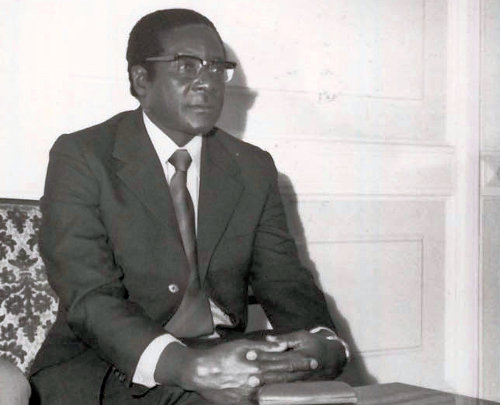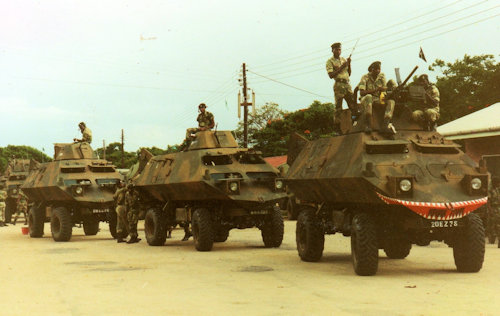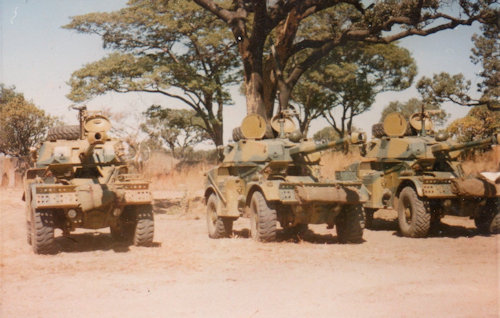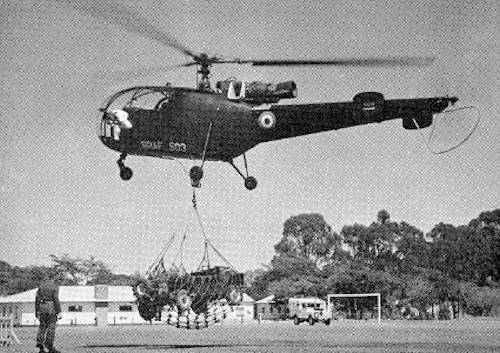Thanks to the commercial intuition of Cecil Rhodes, Great Britain, in the second half of the 800, acquired control of the African areas located west of Mozambique and north of the Transvaal which later became known as Rhodesia. Subsequently, the descendants of the colonizers of these new lands of His Britannic Majesty, for the services rendered to the motherland during the Second World War, the post-war recognized wide margins of autonomy, seen as a prelude to the subsequent definitive independence of the colony.
This independence was opposed, however, by the then government of London, led by Premier Harold Macmillan, as opposed to granting it to the colonies that daily practice racial discrimination as in the case of Rhodesia. In Rhodesia, in fact, alongside a white minority mostly native and of English origin that dominated and guided the local reality, there was a much larger black community object of a rigid policy of separation of the races from the first. A black community that, sensing the development of events, started the protests in the second half of the '50' years to obtain more rights.
Regardless of the demands of this broad layer of society, the white Rhodesians did not change their attitude and came unilaterally to proclaim their independence from the British government the 11 November 1965. It was Ian Smith del Rhodesian Front (former military aviator, during the last World War he had also fought in Italy being downed) widely supported by his fellow countrymen in political lessons. The central point of his political thought was the separate growth of the various populations in the country which, in practical life, materialized in a social apartheid of the black community. The unilateral declaration of independence from the Great Britain of Southern Rhodesia created further instability in the Black Continent, given the contemporary Congolese conflict in progress, generating at least three significant consequences.
 The first consequence was the immediate termination of any political / military relationship with England; the second was the UN condemnation and the approval of a series of economic sanctions to which South Africa, Portugal, Iran and Israel did not join. The third result of the unilateral declaration of independence was, finally, the development of the guerrilla carried out by two black rival rebel groups with different tribal roots. The groups in question were the Zimbabwe African People's Union (ZAPU) (led by Joshua Nikomo) and it Zimbabwe African National Union (ZANU) in which he already militated, as a manager, Robert Mugabe (photo).
The first consequence was the immediate termination of any political / military relationship with England; the second was the UN condemnation and the approval of a series of economic sanctions to which South Africa, Portugal, Iran and Israel did not join. The third result of the unilateral declaration of independence was, finally, the development of the guerrilla carried out by two black rival rebel groups with different tribal roots. The groups in question were the Zimbabwe African People's Union (ZAPU) (led by Joshua Nikomo) and it Zimbabwe African National Union (ZANU) in which he already militated, as a manager, Robert Mugabe (photo).
Thus began a long, asymmetrical, fierce conflict in which African Africans first faced black Africans for the first time.
Thus the ZAPU and ZANU organized their armed components. ZANLA was born in this way (Zimbabwe African National Liberation Army), a military member of the ZANU, widespread throughout the Rhodian territory especially in rural areas, supported by FRELIMO operating in Mozambique, and finally the ZIPRA (Zimbabwe People's Revolutionary Army) for ZANU, which owned its logistic bases mainly in the Zambia border. If, on the level of armaments used, ZANU's military training was significantly lower than his counterpart, before the end of the war, however, he achieved the remarkable consistency of approximately 20.000 fighters, supported and trained by a large number of Soviet military advisers, Cuban and Germans of the East. The ZIPRA, on the other hand, thanks to the foreign support it enjoyed, managed to organize some small motorized units in view of a possible conventional offensive that never happened during the war. So, on the battlefield, black guerrillas often resorted to the use of mines, explosive traps and ambushes.
The rebels opposed the regular Rhodesian forces, armed and structured according to the classic British model. Numerically very limited - in the 1970 consisting of only 3.400 men - they grew to the point of counting in their ranks in the actual 1978, 11.000, to which they had to add about 40.000 reservists (essentially recruited among the only white populations of the country).
 Specifically, the armed forces were articulated on the Rhodesia Regiment with 8 battalions for a total of approximately 800 men, all white, to whom they were flanked Light Infantry, formed by 1000 military, framed in 3 commando and a group of support weapons, and the Rhodesia African Rifles (photo) with 700 men, mostly blacks commanded by white officers.
Specifically, the armed forces were articulated on the Rhodesia Regiment with 8 battalions for a total of approximately 800 men, all white, to whom they were flanked Light Infantry, formed by 1000 military, framed in 3 commando and a group of support weapons, and the Rhodesia African Rifles (photo) with 700 men, mostly blacks commanded by white officers.
Alongside the above mentioned military formations, British South Africa Police, formed by 10.000 men and also supported by reservists. But among the Rhodesian military formations were also the feared and aggressive special forces such as C Squadron of the SAS - articulated on teams of 60 men each - renamed in June 1978 1° (Rhodesia) SAS Regiment, protagonist in the course of the conflict of bold and spectacular shots of hand. To these were added equally famous Selous Scouts. This department, consisting of just military 1.000, specializes in the illegal repression of rebels inside and outside the Rhodesia border and consisted of highly qualified national and foreign personnel after a hard training session at a special center on the shores of Lake Kariba .
Among the special rhodesian formations could also be mentioned the cd Gray's Scouts. These were special troops set up for control of the territory, formed in the 1976 in the wake of similar experiences made by the Portuguese in Angola and come to include among their ranks also numerous foreign volunteers (especially South African but in some cases, even Americans from Vietnam).
As for the armament, the Rhodesian departments were mainly equipped with FN FAL and H&K 33 rifles sold by the Portuguese, but also British L1A1, FN MAG machine guns, 81 mm mortars and other weapons dating back to the Second World War such as the Lee-Enfield, Stone and Bren. Only when the civil war started came Colt M-16 and several examples of AK-47 of war prey.
 Much limited was the artillery park, as it could count only a few 105 yards, as well as armored units that employed only Ferret reconnaissance vehicles together with blind Panhard AML-90 (photo). The Rhodesian military therefore used a vast array of rotated vehicles of both civilian and military origin modified to withstand explosions of mines or other explosive traps. For this purpose Mercedes was employed Unimog, Land Rover, Bedford truck and copies of the Mercedes Benz UR-416.
Much limited was the artillery park, as it could count only a few 105 yards, as well as armored units that employed only Ferret reconnaissance vehicles together with blind Panhard AML-90 (photo). The Rhodesian military therefore used a vast array of rotated vehicles of both civilian and military origin modified to withstand explosions of mines or other explosive traps. For this purpose Mercedes was employed Unimog, Land Rover, Bedford truck and copies of the Mercedes Benz UR-416.
The Rhodesian army could count on a true component only in the 1979 war, when it was over, when it received 8 T-55 Soviet tanks seized by South Africans by a sea cargo sent by Gaddafi to Mozambique.
Alongside the terrestrial forces, the Rhodesians could support an equally valid and efficient military aviation, even if equipped with dated material. De Havilland Vampire FB.9 and T.7 two-fold, sold by the United Kingdom in the 50 years, Canberra B.2 and T.4 formed the main nucleus. To these were added, in 1962, the much more modern Hawker Hunter FGA 9, followed by other means more suited to the COIN role. The 1976 thus arrived 17 twin-engine Cessna Reims 337 Skymaster, highly appreciated for their agility and versatility of armament.
 The helicopter component used instead of the contribution of 34 helicopters Alouette III (photo) and UH-1 Huey. Such means, in combination with the C-47 Dakota, proved to be very useful for the launch of paratroopers, for transport of supplies and assault units, finally - no less important - in the MEDEVAC. All activities that were carried out through Cessna's composite formations Reims 337, armed helicopters and Dakota gergally called "Fireforce". For such tasks, generally, the Lark they were armed with a machine gun from 20 mm MG - 151 / 20 or Browning from 7,62 mm for ground attack. When operating in the transport version, helicopters carried a section of military 4 armed with an FN MAG or 2 Browning.
The helicopter component used instead of the contribution of 34 helicopters Alouette III (photo) and UH-1 Huey. Such means, in combination with the C-47 Dakota, proved to be very useful for the launch of paratroopers, for transport of supplies and assault units, finally - no less important - in the MEDEVAC. All activities that were carried out through Cessna's composite formations Reims 337, armed helicopters and Dakota gergally called "Fireforce". For such tasks, generally, the Lark they were armed with a machine gun from 20 mm MG - 151 / 20 or Browning from 7,62 mm for ground attack. When operating in the transport version, helicopters carried a section of military 4 armed with an FN MAG or 2 Browning.
To give close air support they thought about it Skymaster armed with 8 racers who had replaced the Percival Provost Mk-52 in this role, normally destined for training. Aerial support sometimes provided by the Hawker Hunter, in the event that we had to hire strong groups of enemies. For such situations, in 1979, it was usually assembled Fireforce smaller to form a "jumbo" Fireforce supported on the ground by soldiers transported to the site by light-weight trucks or vehicles.
Generally the soldiers involved in the Fireforce were i Rhodesian African Rifles or those belonging to the Light Infantry. During the war, at the beginning Lark, the Bell 205s were added for their best transport capabilities. As for the air component, instead, Britten Norman was acquired during the conflict Islander, Aermacchi Lockheed AL 60, Cessna 185 Kiwit. Even the Italians Siai SF-260 were bought by the Rhodesians through commercial triangulation with Belgium and South Africa. For war use, however, they had to be modified in Rhodesia with the addition of special wing joists.
(photo: web / John Wynne Hopkins)











